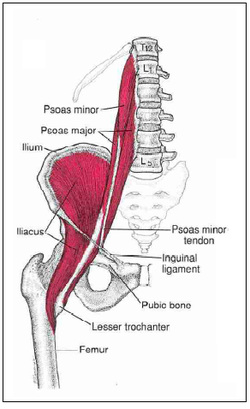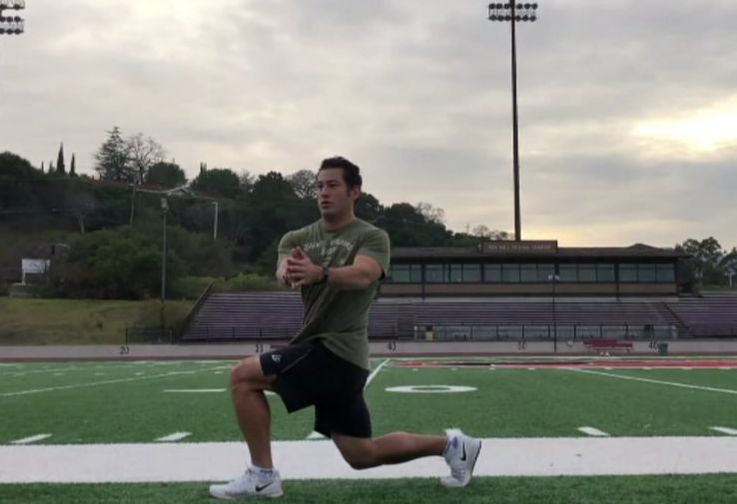|
I am a firm believer of using dynamic stretches before ALL my personal workouts and for about 80% of my client’s workouts. I find it really helps prepare them for their workout and increases long term flexibility. This is nothing new to the sports and training world. Nearly all sports at various levels have some form of dynamic stretching routine prior to practice or competition. This was not always the case and it wasn’t too long ago that static stretching was the only form of flexibility work done during practice. In the 90s when I grew up playing sports, dynamic stretching was unknown. At least this was the case at the jr. high and high school levels where I lived. It was not until 2005 when I went through physical therapy I was taught these series of movements. They called them mobility exercises. Some may call them functional warm-up drills or movements.
0 Comments
Tight Hip Flexors and Quads Can Coincide with Anterior Pelvic Tilt _ Most people have tight quads and many have tight hip flexors. If one or both of these muscles are shortened, anterior pelvic tilt will commonly occur. It is important to have proper length tension relationships between opposing muscle groups to attain adequate posture and function. In anterior pelvic tilt, the legs will have tight quads and/or hip flexors and lengthened/weak hamstrings and glutes. In the trunk, lower back muscles (erector spinae) will be tight and abdominals (rectus abdominus) will be weak. This affects a wide range of the population due to the amount of time we spend sitting. Though there are many causes of lower back issues, excessive anterior pelvic tilt will often result in lower back problems. Normal pelvic tilt for men is 3-5° and for women 5-7°. This angle is measured with one point being the posterior superior iliac spine (PSIS) and the other being the anterior superior iliac spine (ASIS). For an accurate assessment of pelvic tilt, please consult with a qualified health or fitness professional. Safe and Effective Stretches Many people can have tight and dysfunctional iliopsoas muscles. This happens from bad posture or ergonomics in our daily life. I use to term “notoriously tight” because a tight, weak, and/or dysfunctional iliopsoas is coupled with back pain. An article in Dynamic Chiropractic states, "Any and all defects of the spine and the hip joint structures should be evaluated in terms of disturbance of function of the iliopsoas." (1)  From Ilio -Psoas-07-2003 (3) From Ilio -Psoas-07-2003 (3) Iliopsoas Anatomy and Function The iliopsoas is a group of muscles mainly used for hip flexion. The Psoas, two muscles within this group, originates in front of (anterior to) the transverse processes of the T12 to L5 vertebrae and inserts into the lesser trochanter of the femur. (2) Simply put, it starts on the lumbar spine (as well as the last thoracic vertebrae) and connects into your upper thigh. Its predominant function is for hip flexion (bringing your knee to your chest) but, also aids in bending and twisting the trunk, as well as stabilizing the spine. The Iliopsoas and it's Effect on the Body The iliopsoas and specifically the psoas, plays a major part in core musculature. Early in my career instructors emphasized the importance of looking for tight iliopsoas and stretching it. This was pretty easy to spot and to test for, but it wasn’t until a couple years later I found out first hand the problems this can cause. Back pain, sacroilliac dysfunction, degenerative disc disease, groin pain, scoliosis, and more are the result or cause of tight/dysfuncitional iliopsoas muscles. (1)(2)(3). A dysfunctional iliopsoas can even cause pelvic discomfort, bowel dysfunction, burning in the thigh, groin, labia/testicle, and almost always mal posture.(3) I personally experienced some of these common symptoms like back pain sacroiliac pain, and mal posture. I even experienced intense less common symptoms that many doctors could not explain. Read more on Jerry’s experience with psoas dysfunction. The solution to some of these problems may be complex and need much further care, but you can stretch the iliopsoas and specifically the psoas to help you with rehabilitation, post-rehabilitation and injury prevention. It is an easy and simple stretch, but there are some key points to focus on. |
AuthorJerry Yuhara, CPT, CSCS, CMT #75123 Categories
All
JY Fitness
299 California Ave, Suite 120 Palo Alto, CA 94306 650-485-1240 contact@jyfit.com Contact Copyright JY Fitness 2024, All Rights Reserved. Find us on Nextdoor.com
|
